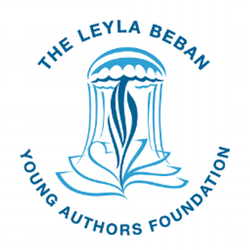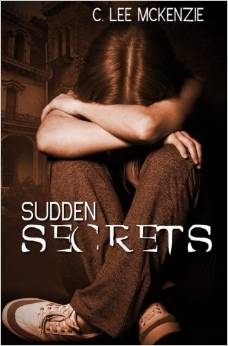
If you can't make the deadline or have a story that doesn't meet the 1000-word requirement, consider submitting to the Bluefire blog, which accepts submissions all yearlong.
Good luck and happy writing!
 I usually feature teen writing posts on Tuesdays, but I came across this contest from the Leyla Beban Young Authors Foundation with an upcoming deadline of February 1st. This contest is for students in grades 6-12 and the main requirement is that the story be *exactly* 1000 words. First prize is $1000 and publication in their literary journal, Bluefire. More details are available on the Bluefire website. If you can't make the deadline or have a story that doesn't meet the 1000-word requirement, consider submitting to the Bluefire blog, which accepts submissions all yearlong. Good luck and happy writing! Today's blog features a guest post from one of my critique partners, author C. Lee McKenzie, about her latest young adult novel, Sudden Secrets.  5 Secrets about Sudden Secrets by C. Lee McKenzie First, I love Secrets, so this post about Secrets has been fun to write. Thanks, Yvonne, for your idea and the chance to be on your blog today. Thanks also for being one heck of a good crit partner. Secret #1 Some of my critique group are cameo characters in this book. Secret #2 My first draft was told from alternating points of view. Secret #3 I gave up on finishing this book two times before I did finish it. Secret #4 After I had a solid draft, I discovered a huge mistake in how old one character had to be, so I had to do some “clever” re-writing. I added a whole new character. But, Shhhh! Don’t tell. If you read the book, see if you can guess which one I added. Secret #5 This book had three different titles before the final one: Beauty, Hidden Secrets (terrible one), Secrets (overused), and then Sudden Secrets.  C. Lee McKenzie is a native Californian. She’s lived in a lot of different places: New York, Laos, Hong Kong, but she always thinks of herself as a California girl. She lives in the Santa Cruz Mountains at the edge of a redwood forest where she likes to hike. When she’s not writing she’s in the woods, in her garden or on her yoga mat. She travels whenever she can. Her favorite destinations are Turkey, Nicaragua, and Southeast Asia, but because she has family in England, Switzerland, and Spain she goes there when she can. In her books she takes on modern issues that today's teens face in their daily lives. Her first young adult novel, Sliding on the Edge, which dealt with cutting and suicide was published in 2009. Her second, titled The Princess of Las Pulgas, dealing with a family who loses everything and must rebuild their lives came out in 2010. Evernight Teen published two of her latest books, Double Negative (this book turned her into a literacy advocate) and Sudden Secrets. Her first middle grade novel titled Alligators Overhead got a thumbs up review from Kirkus and will soon have a sequel, The Great Time Lock Disaster. To learn more about Lee, visit her website and her blog. You can buy Sudden Secrets here: KINDLE PRINT: CreateSpace or Amazon EVERNIGHT TEEN  Canvas Literary Journal Canvas Literary Journal Last January, I featured an interview with Canvas Literary Journal, a market that publishes teens. I checked in with them to see what's new and they are currently running a comedy writing contest with two cash prizes ($20 for first and $10 for second) along with publication in their spring issue. The deadline is February 24. Here's what their literary board has to say about the contest: "From the publication of the Winter issue until the submission cutoff for the Spring issue, Canvas Literary Journal will be running a contest for humorous literature. Any kind of humor (wordplay, satire, just plain absurdity, etc.) and any medium (story, poem, play, etc.) will be accepted. Pieces awarded first place, second place, and any honorable mentions will be published in the Spring 2014 issue of Canvas." Check the Canvas website for more information about entry details and contest prizes. Thank you to Canvas Literary Journal for the update. Good luck and happy writing!
 After a holiday blogging hiatus, I've planned some interesting posts for later in January. For today though, rather than provide a "Friday Five," I'm linking to a guest post I wrote for UncommonYA about self-editing. It includes a series of questions to ask about your manuscript and some reference links to help guide you. If you have some favorite self-editing tips, please share! The usual Friday Five and Teen Tuesday will resume next week. Thank you to Marcia Strykowski for nominating me for The Very Inspiring Blogger Award! Keeping the Blogosphere a Beautiful Place Award rules:
Seven Things about Me:
I’m sorry I couldn’t include all the blogs I follow (so many good ones!). Here are fifteen. 15 Very Inspiring Blogs: C. Lee McKenzie at The Write Game Susan Brody at The Art of Not Getting Published Kathy Temean at Writing and Illustrating Kelli Russell Agodon at Book of Kells Frances Caballo at Social Media Just for Writers Kristen Lamb at We Are Not Alone Kate Ormand’s blog Stephanie Rose Bird at Stephanie’s Studio Special Teaching at Pempi’s Palace Jody Hedlund’s blog Peg Fitzpatrick’s blog Mary Kole at KidLit.com April Henry's blog C.S. Lakin at Live, Write, Thrive Angie Taylor at Band of Dystopian Authors and Fans Congratulations to these bloggers and Happy New Year!
 It's a busy time of year! How can we get writing (and everything else) done? Visit YA Outside the Lines for my guest post today featuring some productivity tips. Happy Holidays!  Thanks to author Jacqueline Jules for including my Pandemic-inspired writing prompts on her Pencil Tips blog. Check them out here. I am taking a brief blogging break for the Thanksgiving holiday. I hoping to be on the Internet less and writing more. Happy Thanksgiving! There are a few days left to enter Figment's Mythical World Contest. Entries of 500 words or less are due at the Figment website by the end of day, November 21. Read complete contest rules and guidelines here. Good luck!
Jim Collins studies leadership and corporate success and he's written numerous business books such as Good to Great, Built to Last, and Great by Choice. One of his concepts is that when undertaking a long (and perhaps difficult) journey, the best approach is to march twenty miles a day regardless of the weather and other conditions. Consistent progress toward a goal is better than long but undependable marches with rests in between. He uses the South Pole expedition leaders Roald Amundsen (who succeeded) and Robert Falcon Scott (who died during the expedition) to illustrate this. (Check this business article for more information about the twenty mile march.)
Now think about writing a novel. Is it better to write many pages on the weekend, skip a few days, and write another large chunk when time permits? Or is it better to write a page every single day? What do you think? School and work may affect the answer to this. Is consistent advancement toward writing goals a key to success? Today's blog features a guest post from Niki Masse Schoenfeldt, author of the picture book Don't Let the Bedbugs Bite. Five Fun Facts about Don't Let the Bedbugs Bite by Niki Masse Schoenfeldt 1. Don’t Let the Bedbugs Bite was originally a short poem I didn’t know what to do with. My critique group, The Mudskippers, encouraged me to make it into a picture book. 2. I wrote the poem after spouting the old bedbug adage to my 2 year old at bedtime and she refused to sleep in her bed if bugs were going to bite her! 3. After ten months of submitting to publishers, Shenanigan Books finally snatched it up! 4. Originally, the bug in the little girl’s bed actually was a friendly bedbug, but my publisher was concerned about the whole bedbug infestation thing (Rightly so!) and suggested I make it a case of mistaken identity instead. 5. After some brainstorming I decided the “bedbug” should be a ladybug because ladybugs are not scary. In fact, my grandmother used to say they brought good luck. Thanks for the guest post, Niki! I've always been told that ladybugs are good luck, too.  Don't Let the Bedbugs Bite is a featured book through the READING RAINBOW LEARN & READ app from Itunes. Bio: Niki Masse Schoenfeldt grew up in a small town in Western Massachusetts where she began writing stories as soon as she could pick up a pencil. In the fall of 2008, her first picture book, NATURE’S LULLABY was released and her next picture book, DON’T LET THE BEDBUGS BITE! followed in 2012. Mrs. Schoenfeldt continues to write picture books as well as middle grade and young adult novels. Over the years she has worn many hats, including that of a book reviewer, critique group moderator, math & reading tutor, storyteller, mom, wife, painter, professional beach bum and she even once saved a sheep from drowning! |
JOIN NOW!
Sign up for Yvonne's newsletter for exclusive content, book news, and other occasional author goodies. Archives
June 2025
Categories
All
|